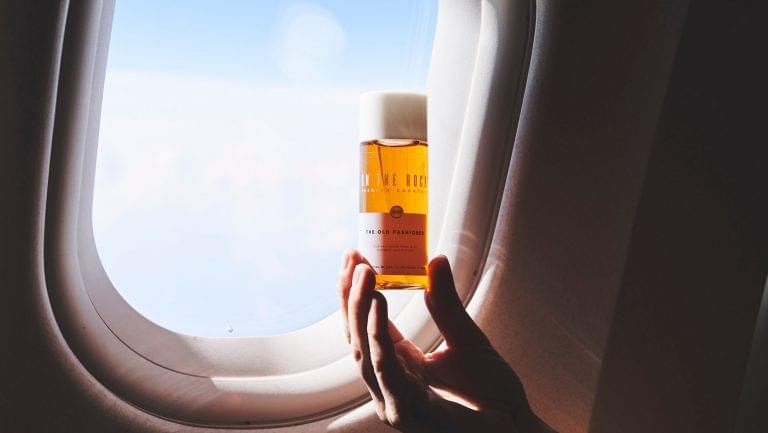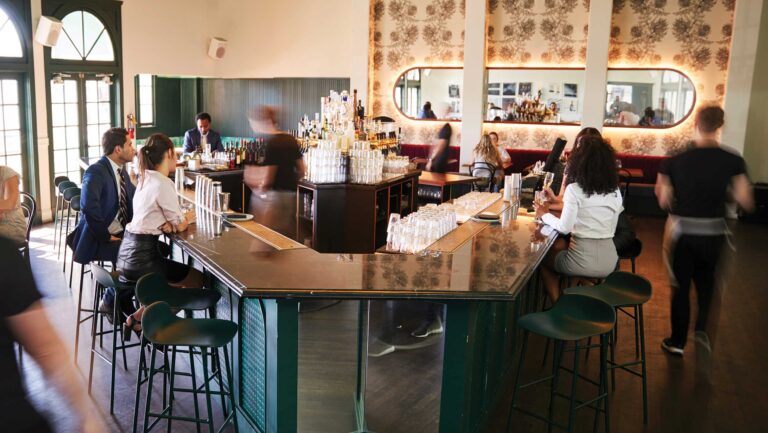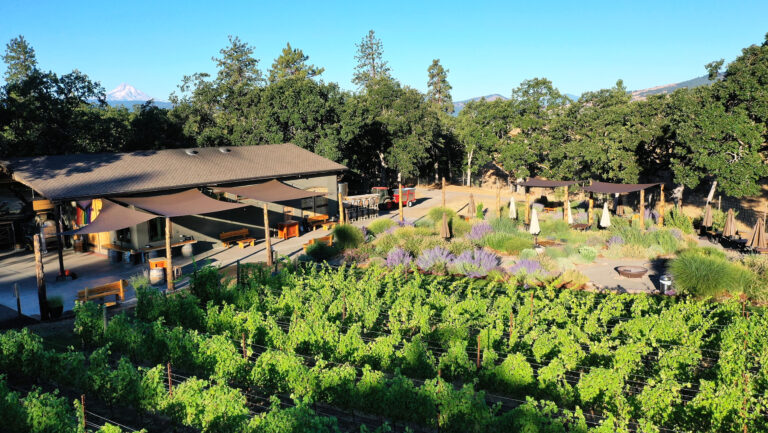It’s been a long time since American Airlines dazzled passengers with its 747 Luxury Liner Piano Bars—around 50 years, to be exact. American’s ads for the piano bars claimed, “Our passengers get the best of everything.”
But as the U.S. airline industry changed over the years, devoting so much space to an amenity like a piano bar seems almost comical. These days, such luxury spaces are usually found on flights on non-American airlines. “The days of using a significant amount of real estate in the airplane for entertainment are mostly over for domestic carriers,” says Rob Bradford, the managing director of global product design and delivery for United Airlines. “We’re trying to fill every seat and make sure we optimize our assets.”
But while piano bars might be out, airlines are paying more attention than ever before to their drink offerings. Not only are they motivated to differentiate themselves in an increasingly competitive industry, but the many new alcoholic beverage options that are available—whether premium-quality bottled cocktails, craft beers, or artisanal spirits and wines—allow them to get more creative with their beverage programs.

Don’t miss the latest drinks industry news and insights. Sign up for our award-winning newsletters and get insider intel, resources, and trends delivered to your inbox every week.
“The basic drivers,” says Ty Muckensturm, the director of catering and logistics for American Airlines, “have been customer preference and demand, and just prevailing market trends.”
A Strategic Amenity
As the airlines have looked to boost profits, one of the strategies they’ve used is to try to upsell customers. United Airlines has created Economy Plus, for example, a section at the front of the main cabin with extra legroom and complimentary beverages and snacks. (Typically, in the main cabin, alcoholic beverages currently cost about $7 for a beer, $8 for spirits, and around $9 for a glass of wine.)
Beverage programs have played a useful role in defining the added value of such premium seats, the airlines say. A good example of this is the Mint “experience” at JetBlue, an airline based in New York. Mint, introduced several years ago, is positioned as the carrier’s First or Business Class equivalent and is available only on select longer-haul flights. For a premium price, customers get more space, lie-flat seats, and big TV screens with unlimited entertainment; rounding out the experience is a carefully picked selection of complimentary food and drinks. “We really focus on Mint providing a restaurant-quality experience,” says Jessica Brown, a representative from the company’s Onboard Experience Team.
Leveraging A Sommelier’s Expertise
To do this, JetBlue partners with the wine consultant Jon Bonné on the wine offerings and the New York City restaurant Saxon + Parole for its meal options. “By working with Jon Bonné on our wine selection,” says Brown, “we’re able to create a kind of curated experience that customers wouldn’t find everywhere.”
In fact, JetBlue’s Mint has earned such a good reputation that the program is now able to partner with some well-respected smaller wineries. “A lot of these small producers don’t necessarily want to be associated with mass airlines that don’t offer the same kind of customer experience that JetBlue does,” says Brown. “We’re able to offer wines that you really only see in very niche establishment restaurant settings. They’re hard to come by.”
Bonné explains that the chief principle guiding the selection of most products featured in the Mint program has been that they be made at an artisan scale by small companies. “This is an essential piece of the Mint experience and reflects JetBlue’s company values,” he says. “It’s why, for instance, the ice cream selections are from local purveyors in Mint cities. And it’s no different with the wine. I look for high-quality wines made in small quantities by small, talented producers.”
JetBlue, Bonné points out, was very deliberate in choosing to work with the New York City restaurant Saxon + Parole and its executive chef, Brad Farmerie. “They wanted a refined [dining] experience on board,” says Bonné, noting that the wine menu, similarly, features bottles that might be found on a list at a top restaurant in any Mint city. “We started from the premise that there was no reason wine in premium class couldn’t be better than what most U.S. airlines were offering—it just required the will to want to do things differently.”
Many of Mint’s wines are highly allocated, says Bonné. “We often take a significant portion of a winery’s production—something I’m able to accomplish because the producers appreciate how different Mint is from other premium onboard experiences,” he says. “And many have become regular Mint customers. That has given us access to a lot of elite wines, from producers like Turley, Failla, Matthiasson, Bethel Heights, Domaine de la Côte, and so on. They enjoy the brand association and the fact that we’re committed to highlighting the work of small, high-quality producers like themselves.”
Flight attendants who work in the Mint program must also undergo special training. “The service is key,” says Brown, “and it’s unmatched.” Mint has been so successful for JetBlue that the carrier continues to expand the program. In the last year, it has added round-trip flights from Boston and New York City to Las Vegas and Seattle.
Diversifying Beverage Programs
Outside the continental U.S., beverages also play an important, albeit different, role—with Hawaiian Airlines. Because the airline is closely associated with vacations, Hawaiian’s alcoholic beverage program—which accounts for nearly 40 percent of annual onboard revenue—aims to get the holiday started as soon as the customers board. All drinking-age passengers are offered a complimentary mai tai made with Koloa Rum from Kauai. The airline also serves other Hawaiian options, such as Ocean Vodka, a brand based in Kula, as well as beers from Maui Brewing. “We like to bring as much of Hawaii on board as possible, whether it’s in our beverage offerings or in our meals or other food items,” says Renee Awana, the managing director of product development for Hawaiian. “All of those aspects we try to infuse with local flavors or experiences.”
United and American, among the nation’s oldest airlines, are also diversifying their beverage programs. American’s beer offerings, for example, have recently expanded to include craft beer, like Voodoo Ranger IPA from New Belgium Brewery in Fort Collins, Colorado. “We took a step a back, reviewed our beer portfolio, and found we had a lot of lagers but didn’t have different types of beer,” says Muckensturm. “So we wanted to capture the trending craft market.”
In February 2018, American enlisted Master Sommelier Bobby Stuckey to lead its wine program. Other airlines have also partnered with wine experts in an effort to step up their programs. United has partnered with Master Sommelier and Master of Wine Doug Frost, and since 2007, Delta has partnered with Master Sommelier Andrea Robinson in the creation of a rotating wine menu that pairs with Delta One meals.
Robinson’s wine selection involves a year-round process, including a balance of in-air and on-the-ground tastings, that culminates in a final selection each year at Delta’s general offices in Atlanta. Selections include recognizable brands for the occasional wine drinker and, as the company says, “surprises and delights for the most discerning of wine enthusiasts.”
As JetBlue has provided training for Mint, Delta launched Sky Sommelier in 2012, a program that consists of an online series of courses designed so that flight attendants can increase their knowledge and enhance their skills in the onboard presentation of Delta’s wines. Since its inception, more than 1,000 flight attendants have graduated from the program. The program is available to all of the airline’s 22,000 flight attendants.
Hawaiian Airlines, along with United, has also partnered with On the Rocks, a company that makes premium bottled cocktails, which the carriers have found to complement the logistics of airline travel. “The flight attendants are serving out of a cart in the aisle, so we want to keep their service as efficient as possible,” says Awana. “We would not want flight attendants in our main cabin having to spend a lot of time trying to mix a lot of complicated drinks.”
For Hawaiian Airlines, On the Rocks provides a custom-made Lychee Vodka Martini, a Li Hing Vodka Gimlet, and a mai tai. The ready-to-drink cocktail company began supplying some of its bottled cocktails to airlines after an executive with Virgin America (now part of Alaska Airlines) expressed the need for a better-quality premade cocktail. “He was just openly talking [with one of my business partners] about how ‘airlines need bottled cocktails. There’s no reason why we couldn’t have a better experience for our guests,’” recalls Andrew Gill, a part owner of On the Rocks and its chief strategy officer. The company’s first partner, though, was Hawaiian Airlines, in 2016; United followed in May of this year.
Gill says that what makes his brand stand apart from the other packaged cocktails coming onto the market is that they’re bar quality—made with high-quality spirits, all-natural ingredients, and no preservatives. “If you’re having one of our mai tais on Hawaiian Airlines,” he says, “it should have the same balance as the mai tai that you get at a bar.”
Gill also says that the company makes it a point to deliver what an airline wants from a bottled cocktail: The cocktails are packaged in plastic bottles, cutting down on the risk of breakage. And they’re made to taste slightly stronger, given that a passenger’s sense of taste can be somewhat dulled by flying at high altitude.
A Careful Balance
When it comes to what beverages they bring on board, the commercial airlines have to carefully balance the benefits of pleasing their consumers with the realities of air travel: space limitations, weight restrictions, and packaging that’s safe and efficient. They would all love to be fully stocked flying restaurants or bars, but the reality is that what they can offer must for the most part be squeezed into the compartments of narrow galley carts.
But the situation sometimes calls for exceptions. United’s Bradford says that at times there’s just no substitute for serving a fine wine out of an elegant glass bottle. “What I don’t want to do,” he says, “is show up for someone in our Polaris cabin who’s paid $5,000 for their ticket with a box of wine or some other type of container that they would not perceive as being of the quality that we want to give them.”
Hawaiian’s Awana also recalls that when the airline started using the narrow-body A321, one brand of gin that was served on board was affected because the new plane uses a trash compactor. “The trash compactor doesn’t like glass,” she says. “Recently our gin bottle partner changed to glass, so we said we need it in PET [plastic bottles] instead.”

And while airlines would love to serve all of the latest drinks to their customers, space constraints require a lot of picking and choosing. As a result, there are typically steadfast rules: an ongoing rotation limited to four beers and five wines, for example. Whittling down the thousands of beverages available today to just this rotating shortlist is one of the biggest challenges of running a beverage program on an airline, managers of these programs all say, and it requires a huge ongoing research and analysis effort to stay on top of industry and consumer trends, conduct tastings, and consult with their beverage-expert partners.
But the decisions can sometimes be rather easy—such as when United decided to begin serving the beer brand Stella Artois on its flights all over the world. The beer’s wide appeal and its global availability made Stella a great fit for United and its many international routes. Ultimately, though, running a beverage program for an airline requires perspective. As American’s Muckensturm points out, “This all obviously [plays] second fiddle to safety and just general transportation efficiency.”
Adds United’s Bradford, “I think customers are probably a little more forgiving that we’re in a tube that’s flying five miles above the earth at 500 miles an hour, and they’re maybe not going to have that particular vodka brand they prefer.”

Dispatch
Sign up for our award-winning newsletter
Don’t miss the latest drinks industry news and insights—delivered to your inbox every week.
Andrew Kaplan is a freelance writer based in New York City. He was managing editor of Beverage World magazine for 14 years and has worked for a variety of other food and beverage-related publications, and also newspapers. Follow him on Twitter at @andrewkap.







